Three-month averages have been steadfast: higher-than-normal job creation and wage increases.
By Wolf Richter for WOLF STREET.
Look, today’s jobs report shows why we don’t get too excited about the month-to-month squiggles in the jobs data (blue lines in the charts below). The labor market doesn’t turn around from one month to the next suddenly, unless something huge happens, such as Lehman or a lockdown. We’re paying closer attention to the three-month averages, which iron out some of those squiggles and include the revisions of prior data (red lines in the charts below).
So today, the jobs report by the Bureau of Labor Statistics came out hot for May in terms of jobs created (272,000) and in terms of wage increases (4.9% annualized).
They were hotter than “expected,” and stock futures tanked instantly when trading bots saw the headline because Wall Street wants a big-fat recession that would “force” the Fed to cut rates and end this horrible record QT and start QE all over again, but the economy is not cooperating with this dream.
A month ago, the jobs report for April had come out a little cooler, with a revised 165,000 jobs created and wage increases of 2.8% annualized. It was hailed as the beginning of the infamous and long-prayed-for slowdown in the labor market that would “force” the Fed to cut rates, or whatever, and helped promote the surge in stock prices.
But the three-month averages have been fairly steadfast for about a year showing what you’d expect from an economy that is moving along at a faster-than-normal clip, with higher-than-normal job creation, and with higher-than-normal wage increases documenting the inflationary environment that the economy is in.
Over the past three months, including revisions, employers created 249,000 new jobs per month on average – so that’s a net increase in payrolls. It has been in this range all year. There was somewhat of a slowdown in the second half of 2023 that has now vanished.
The three-month-average readings so far this year have been above or at the peak readings in the five years of the Good Times before the pandemic. For the US job market, these are big increases in employment.
We can also see in the blue line how volatile the month-to-month data is and that it cannot be used as an indication of a trend – though that’s all the headlines are about. It just gives you whiplash:
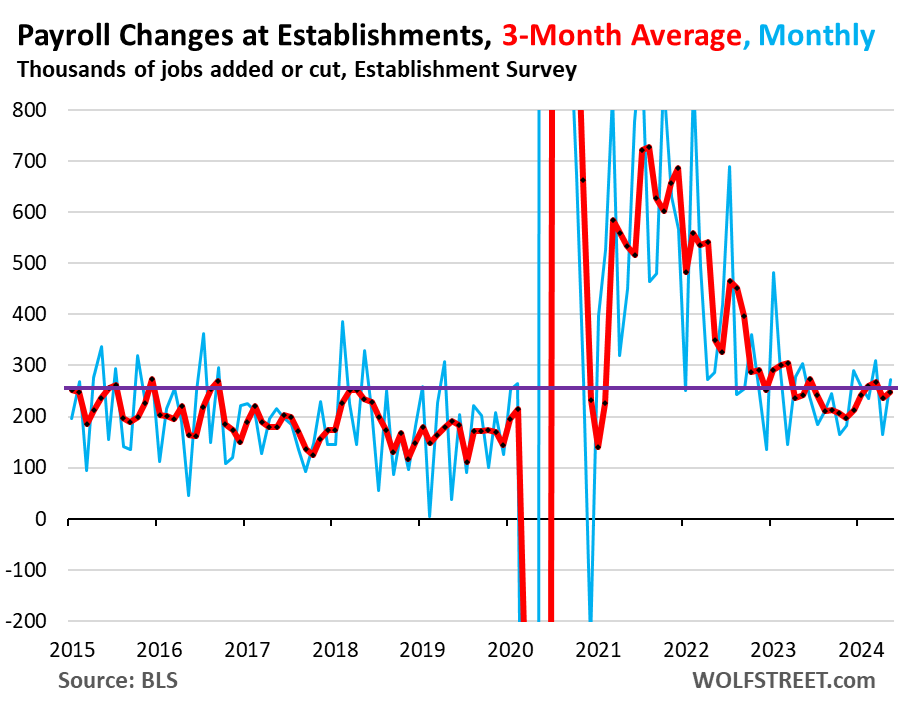
The total number of payroll jobs at employers rose to 158.5 million, a year-over-year increase of 2.76 million jobs (+1.8%). For the US economy over the past 20 years, these are substantial increases. No slowdown in sight either:
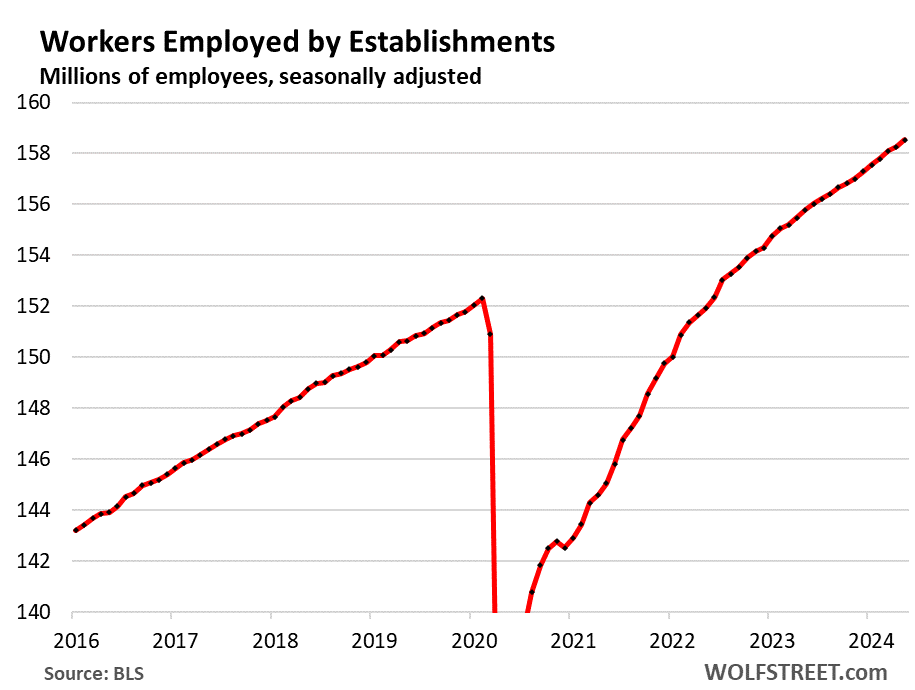
Average hourly earnings increased by 4.9% annualized in May from April, the biggest increase since January, and the second biggest increase since July 2023, according to the BLS survey of employers today. But it came after the small increase of 2.8% in April, and a 4.6% increase in March (blue in the chart below).
So the three-month average, which irons out some of those squiggles, rose by 4.1% annualized in May, well above the normal levels before the pandemic (there was only one month with higher readings in the five years before the pandemic, and the majority of readings were in the 2% to 3.5% range. So this speaks of higher inflation in the current economy.
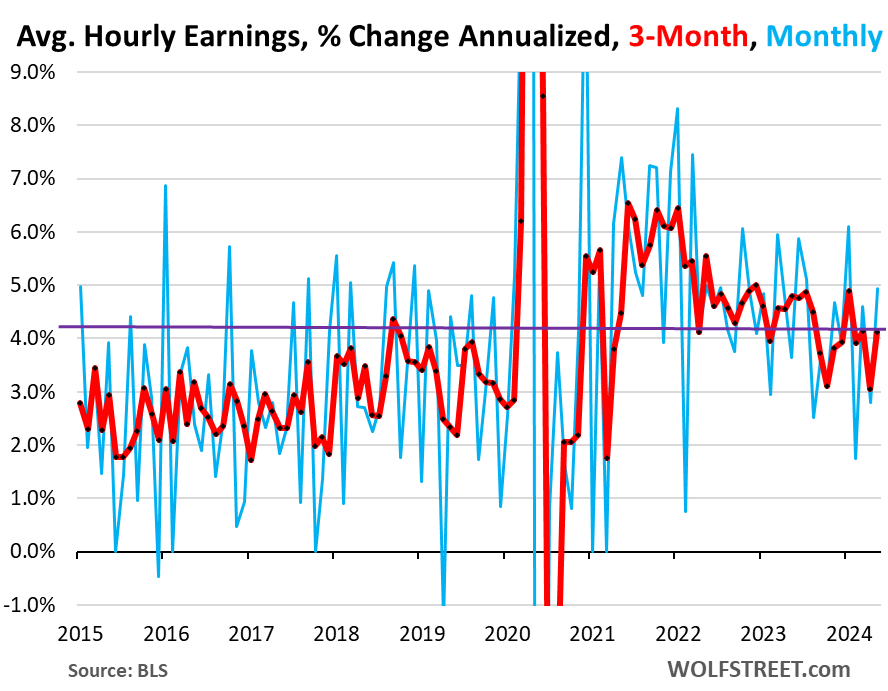
On an annual basis, average hourly earnings rose by 4.1%, a faster pace than in April (4.0%), and well above the five-year prepandemic range of 2.5% to 3.5%.
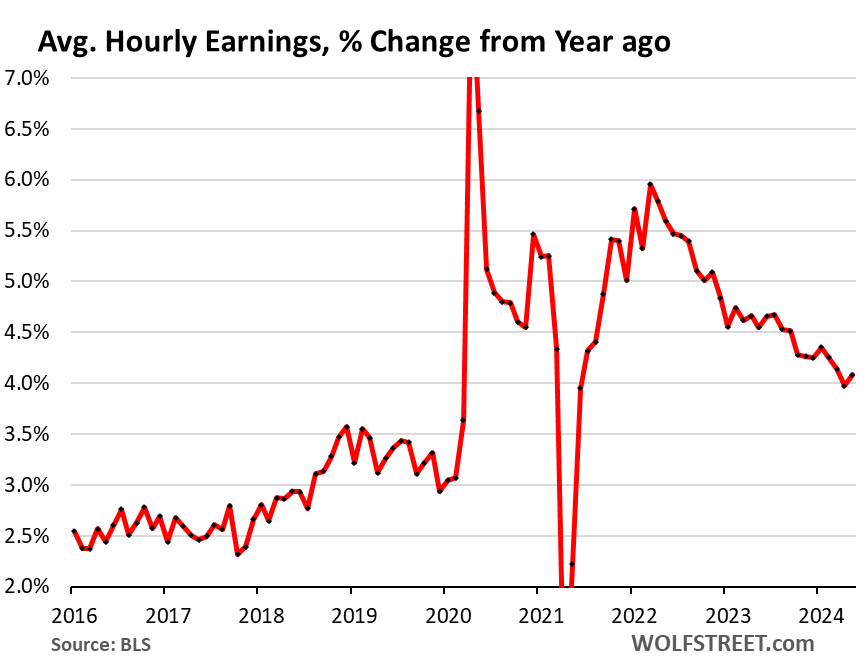
Household survey data messed up by huge undercount of immigrants.
The Bureau of Labor Statistics also releases a trove of data from its survey of households, including total employment (which include farm employment and self-employment), part-time employment, full-time employment, labor force, participation rates, unemployed, unemployment rates, etc.
All of this data is based on household surveys that are then extrapolated to the population estimates by the Census Bureau.
However, the Census Bureau has underestimated the mass-migration in 2022 and 2023, and has therefore underestimated the population growth, and overall population.
The Congressional Budget Office (CBO), in its population estimates, picked up on the huge wave of immigration by also including data from Immigration and Customs Enforcement (ICE). It estimated that net immigration in 2022 was 2.67 million immigrants, and in 2023 was 3.3 million immigrants, the highest in its data going back to 2000, and about triple the average rate between 2000 and 2021 (1.05 million immigrants per year).
In terms of population growth:
- CBO: 0.89% for 2022 and 1.14% for 2023, the highest since 2005.
- Census Bureau: 0.36% for 2022 and 0.49% for 2023.
We discussed this in detail here: How the Huge Wave of Immigrants into the US in 2022 and 2023 Impacts the Employment Data of the BLS Household Survey
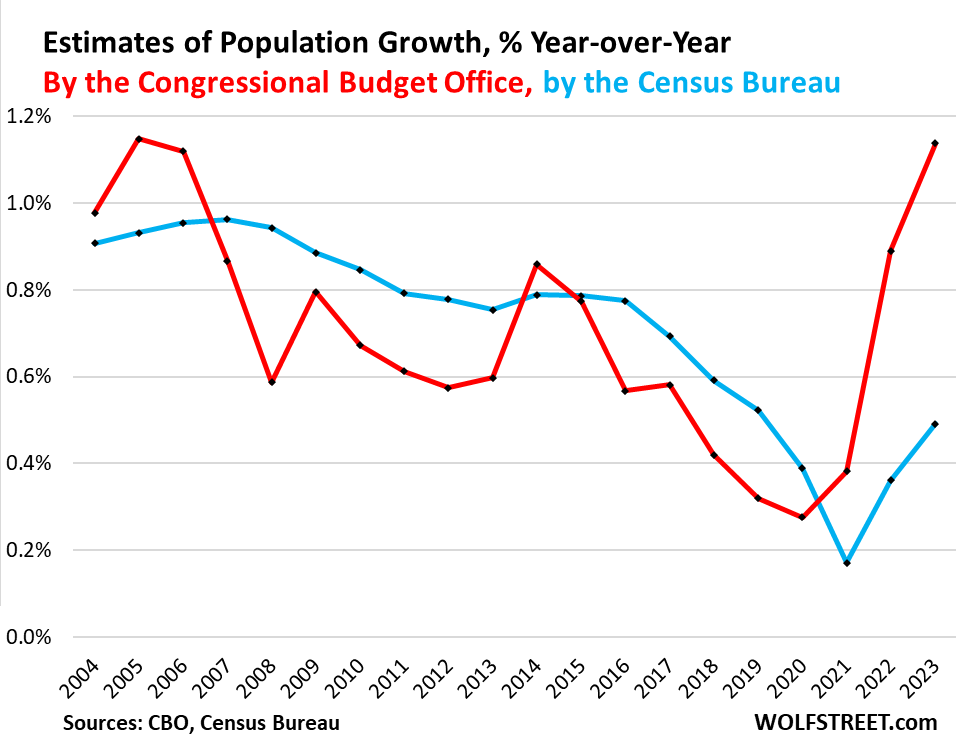
Because the BLS extrapolates its household survey data to the wrong population estimates by the Census Bureau, it understates employment and the labor force and messes up all other metrics based on them. So we will no longer cover the household survey data for that reason until the Census Bureau revises its population estimates, which it does periodically. Right now, it just doesn’t make sense.
The Census Bureau has also overestimated the prices of new single-family houses sold during the pandemic, and in its revision in May revised away 25% of the price spike of new houses during the pandemic. We’re now waiting for a massive upward revision of the population estimates before we report on the BLS’s household data again.
Enjoy reading WOLF STREET and want to support it? You can donate. I appreciate it immensely. Click on the mug to find out how:
![]()


GameStop stock only fell about 40% today so it is doing nicely!
Yet still up more than 25x over the last five years… Might there be more than meets the eye? Who knows? Only time will tell.
Gold plunged a record $82.00 an ounce in a single day, which was a really nice and refreshing move on its way to $20 per pound!
Sure hope it pulls back at least 10%. Still have some trash paper I need to covert to something with a future!
Sounds like we have a great economy
Precious metals were absolutely crushed today as the USD was the bully on the beach kicking sand in their faces. Silver down over $2 and gold down $85. So much for the dollar weakness!
Indeed, and the US dollar soared while US Treasury yields rose dramatically as they needed to do and the yap about the Federal Reserve cutting any rates got thrown into the garbage bin of history.
Would the disparity between the BLS and the census bureau be throwing off recession indicators such as the Sahm Rule?
We know that the BLS now understates employment and the labor force and related measures due to the Census Bureau’s underestimate of the population. But I’m not sure how, or in which direction, it messes with the rates, such as the unemployment rate, that the Sahm Rule relies on.
My favorite recession indictor doesn’t rely on this data, it relies on unemployment insurance claims, so these are people who lost their jobs and file for unemployment compensation. These are fairly raw numbers of actual UI claims.
https://wolfstreet.com/2024/05/09/our-favorite-recession-indicator-next-recession-keeps-moving-further-out/
Stocks on the other hand shrugged it off staying at ath
Bad news is still good news.
There were several 5 minute periods today that would have proven otherwise!
If all this is not a good thing, than what is? Meaning, if someone is somehow trying to spin this as ‘bad news’, then I ask what would ‘good news’ ever look like?
The government’s investments in bringing jobs back home and the reduced sizes of later generations as Baby Boomers retire mean there must be worker shortages overall in the US in coming years, absent immigration. On the other hand, if AI controlled robots truly improve enough, maybe they will take over more jobs, due to cost savings, regardless of how the economy is doing.
Powell pulling hair dot jpeg
Chairman of the Federal Reserve Jerome Powell has been very correct about everything and is quite happy interest rates are headed higher as we are about to enter Summer 2024.
“Hooray, my efforts to cool the economy are failing, thus affording me the opportunity to continue to fail to cool the economy!”
I mean, it makes good fanfic for people who think Powell is a genius playing 4D chess, but I really really doubt it.
FOMC officials really ought to take the words “rate cut” out of their vocabulary for the time being. Given their abysmal track record at economic forecasting, a simple “we’re data-dependent” would suffice.
When/if the time is appropriate for easing, it will be evident to everyone.
They never should have put it in. To their (grudging, coming from me) credit, they appear to understand this now.
Is the fed Laser Focused on a soft landing?
Or laser focused on inflation?
You are being jabbed in the face by 3-4% continuing inflation, after taking a “one-time” 20% inflationary gut punch.
Does that answer your question?
You left out 5% on savers and T-bills and S.S. recipients. Do your homework, and save money
I’m not sure when we took flight?
Are you sure we’re in the air?
When and where were we going?
Most likely we’re not even in the air, we might be in a boat out at sea, bouncing aboutwe. I say were on the roller coaster at Powells amusement park, going round and round up and down. The side show freak, and the fat lady aren’t in town for nothing.
People are getting bored with the roller coaster, but at the back of the amusement park, there is a zeppelin on a 10,000 rope called Hindenburg II. Maintenance man Chuck Bernanke checked it out 15 years ago and says its totally safe. To accommodate total park attendance, Chuck can stitch on additional rope to find faster air streams. For extra charge, there’s a smoke room in the back where fat cats can light up their cigars and steer the thing. It’s a big money maker.
How long until Wall Street figures out there is not going to be a big-fat recession?
Part time job holders st 8.4 million in May. Highest on record. That’s not the correct kind of hot.
Maybe not the best hot for some folks EV, but I can testify that I have had two and even three jobs at times, with 1 or two of them being ”part time” because the employers could not find others to do the work I was doing.
Many friends similarly would work 0600 to 1430 at one place, then move to another place and work 1500 to 2100, etc.
Unlike some others we know, WE, in this case the family WE, paid off all our debts doing exactly thus, and are now enjoying a low stress life.
From what I read on here, I suspect other regulars on Wolf’s Wonder have become debt free doing the same thing, eh?
Make hay while the sun shines!!!
I think it is safe to say a lot of people with a higher income, and actually have a job, have more than one job. But also safe to say that unfourtunatly the people on the other end of the spectrum also have more than one job.
For example, there are millions of mom-and-pop landlords in the US, owning 11 million single-family rental houses. Many of them treat this is a part-time job, in addition to their day job, and so many of them are captured in the part-time jobs, and in the multiple jobholders. This goes with other activities. There is a lot of BS circulating about these “part-time jobs” and “multiple jobholders.” This stuff get really tiring month after month forever.
I did the same, Vintage. And loved all three of my jobs…only one was full time. Employed my teen son for reno work and took my wife along on many flights on the BC coast. It never seemed like work.
I worked ~0700 to ~1900 most weeks M-F when I was single in my 20’s and 30’s and I would guess that WAY less than 1% of the population works even that much for more than a few years in a row. May have done some short term stints of ~0600 to ~2100, but I would guess that less that 1 in 1,000 have every worked 75+ hours a week EVERY week for more than a couple years in a row (e.g. IB analysts, MD residents). I’m wondering if VintageVNvet will let us know how long he worked the 15 hour days. P.S. I can never understand why more people don’t take a second job to get out of debt, since even unskilled work like catering set up and tear down (that is usually on nights and weekends) will pay pretty well (and if you learn to bartend to do any kind of home maintenance you can make great part time money)…
Or, maybe you could work less and attempt to enjoy your brief flash on this planet.
There’s more to life than money.
Because of potential family obligations I know of a few that take on the part time work but the manual labor becomes very difficult to manage . That said I am a big proponent for part time work for people that are willing to take on these tasks
A tripod is the first stable structure in the physical world, my grandpa told me. Not sure if he meant that as business advice but being self employed all these years I’m glad I took it that way because it served me well.
Bulfinch find something(s) you like doing. You can see the world at the same time if you work it right and get em to pay you for it. You won’t like having to eat dogfood when you get old.
Not too long at any one time, but when I could, I did.
Even working my way through college when the GI Bill paid a whopping $90 per month, I would have a ”steady” job M-F, usually at the school, and then enjoyed working various odd jobs on weekends or schedule classes 3 days a week, etc. Manual labor has always been kinda like physical therapy!
And, as Wolf comments, a lot of work side by side with the landlords, cleaning or painting, etc.
I have also taught at high schools full time, then did remodeling after or weekends.
I agree that ya gotta enjoy the work you do to be able to keep it going for any length of time.
Amen brother! We’re probably from the same era. An era when 2 or 3 jobs were necessary to get a start in life. Well worth the effort looking back the past 50-60 years.
Well with uncertainty, our company is reducing full time (2 yr) contract staff as contracts come up for renewal. These people are afforded all benefits of full time permanent staff so a reduction in them saves considerable amounts. In leu, temporary part-time staff are hired from agencies when needed only. They get a slightly higher rate of pay but no benefits but they afford a good shock absorber to new short term orders if needed.
and are dismissed on an hours notice once that rush is passed.
The books however are not carrying any decent long term contracted works atm so the uncertainty is very stressful as overheads and leases keep being billed. Thank goodness for part timers and I am thankfull we have this option.
I failed to note, some part- timers we employ are so good and so reliable we ask that we be able to contact them away from the agencies when the situations improves because their employ is generally a rush job and a few respond with such outstanding work efforts it would be idiocy not to have them as a permanent when the job orders expand. Management loves to test drive a new model
Multiple job holders as a % of employed is 5.2%. Which is at the average of the last 30 years.
What would not be hot if those 8.4 million part time job holders could not find the part time job.
It’s always comical to watch the billionaire investors pray for a recession and then not get one, walking away pouting about the fact people still have jobs.
Where do you people get this fantasy garbage?
To be fair to the evil billionaires, they don’t actively want the recession. They want the free and cheap money from the inevitable Fed overreaction to the slightest hint of a recession.
The majority of posters here are pulling for a recession.
I would love to see oil climb up to $85 or higher sooner rather than later. Inflation is moderating, in part, because oil is off $10.
Absolutely the drop in oil and NG has a dramatic effect though looks like OPEC plus is looking to fill some gaps in any production shortfalls keeping a lid on oil prices. The USA is selling their 1 million bbls of stock piled gasoline late June and July they stored after Sandy. I wondered why in the world they felt compelled to store in the first place glad that’s getting sold .
If this keeps up the media will have to retrain their AI to put “highest Fed funds rate in 24 years “ in every article they generate.
But will the FOMC be able to resist cutting rates when the ECB and BOC are cutting theirs? What will the dot plots show? I think there are some Fed members who are dying to cut rates.
The circus parade looks like it going to keep on marching along. When will the car stop and how many clowns will get out of it?
Seems to me that if foreign central banks cut their rates, it will increase the value of the dollar at the expense of export businesses and increase reliance on cheaper imports. With some lag, the U S economy will slow due to the overvaluation (relative to other currencies) of the dollar, eventually forcing the Fed to lower rates.
And the higher dollar will push up stocks as foreigners pour investments into dollar denominated assets.
Asset carry-trade?
If this keeps up the media will have to retrain their AI to put “highest Fed funds rate in 24 years “ in every article they generate.
But will the FOMC be able to resist cutting rates when the ECB and BOC are cutting theirs? What will the dot plots show? I think there are some Fed members who are dying to cut rates.
The circus parade looks like it going to keep on marching along. When will the car stop and how many clowns will get out of it?
It just goes to show how all of the financial markets are NOT trading on the fundamentals (supply, demand, price differentials etc) but only on one thing: the Fed and their interest rate fix. Something is truly rotten in Denmark when that has become the ONLY thing that matters.
It’s all about the trillions of funny money pumped into the market. Interest rates have had little effect compared to that.
I don’t call it humming, more like muttering swear words under its breath. But the Marie Antoinette crowd doesn’t know what the grind is for the average person.
The “average person” is eating more cheeseburgers and adding tattoos where skin is still clear. The really lower classes are the ones who are hurting and in despair.
Maybe the lower class are scratching their heads and wondering how they ended up in the lower class. So she get a second job and discovers she is still in the lower class but now she’s to tired to care having worked 16 hours a day.
So in the morning she quits both her jobs, grabs all her belongings and jumps on the freeway and leaves her lower class life behind.
She came back 20 years later to say hello…then goodby.
Lol interest rates are fundamentals and they’re not trading on that either or they’d have kathoomphD like bonds have.
They trade on fear and greed. Last two years and most of the last few decades trading on a lot of greed… Near ATH of greed I believe lol
The wage increases are due to a wage-rent spiral that no one is talking about even though it is as plain as day in the actual data.
Spelled out:
(1) Early career employees make up the vast majority of renters.
(2) The wage increase percentages in the *wage data* have been the largest at the low end of the pay scale.
(3) The *CPI print is overwhelmed by shelter inflation*, and rents have increased 0.4% or more *per month* for about three straight years.
(4) Being able to afford shelter is a non-negotiable point in accepting a job for essentially every job seeker out there, other than a few very desperate or very eccentric individuals. No one will take a job that doesn’t cover the cost of shelter, pushing up wages in a no compromise fashion. Whether people *could* double or triple up as roomates is irrelevant to this argument because at the end of the day, the *available vacancy rate data* remains extremely low.
-QED
I wouldn’t say futures crashed… Quickly bought up and then barely down 10 bips at the close after another ATH was a really weak day for bears.
However IMO BTFD is about to get rocked. Possibly next week, CPI and a new SEP.
One cut or two will be the question. I’m thinking longer term neutral has got to go up. Maybe that’ll tank this thing.
Seems to me markets are going to be in a no win narrative soon enough. Bad news is going to point to stagflation, good news higher rates. Almost popcorn time
“I wouldn’t say futures crashed”
I wouldn’t either. In fact, I said, “futures tanked.”
Crashing and tanking are not the same thing. So maybe the sequence in order of severity is: Dip, drop, tank, plunge, crash, kathoomph.
It’s nice to get clarity on the technical terminology. Thanks! I will put it on file.
Lol fair enough ready for the kathoomph whenever you are!
Kathoomph has been in standard use here for a while, maybe since early 2022 or maybe even late 2021. It first appeared in a headline in May 2022:
https://wolfstreet.com/2022/05/01/as-ipos-kathoomph-exit-doors-close-with-big-implications-for-the-broader-startup-scene/
Very funny. Please write an article some day with examples of each event.
Puked is one I like when it :drops, tanks and plunges.
where does “rug pull” fit in
rug pull and kathoomph are synonyms.
Headline inflation is going to drop big due to oil. The big question is core. Cleveland is predicting another +0.3% CPI / +0.23 PCE which is above-target but nothing alarming.
Pretty decent point…
While the unemployment rate (thanks to its…creative…definition by the G) *can* increase even as payrolls increase (due to creatively defined “labor force” increasing too…) it becomes harder to swallow as we’ve been told for quite a while now (by the G) that payrolls are at/very near maximalist, historical highs.
So where is the growth in “labor force” (justifier of rising unemployment rates, see above) coming from so fast? From illegals? Who we were told 10 minutes ago (by at least a big chunk of the G) didn’t exist (in anywhere requisite numbers to alter unemployment rates, housing demand, etc?)
This is why it is important to spend some time looking at the G’s not-always-common-sense methodological constructs…especially when proffered metrics seem to be going in weird and/or contradictory directions.
Another point…it would be really interesting/telling to see the sectorial breakdown of Wolf’s reported payroll gains for past month/year/two years.
Spoiler – Two of the sectors providing most of the payroll gains are directly levered by government spending…not exactly a sign of a healthy private sector despite topline ballyhoo.
“Another point…it would be really interesting/telling to see the sectorial breakdown of Wolf’s reported payroll gains for past month/year/two years.”
All you have to do is read this stuff. When I post these articles, almost no one reads them, and then I have to put up with this nonsense in the comments:
https://wolfstreet.com/2024/06/08/longer-term-trends-of-employment-by-industry-category/
And the prior one from a month ago:
https://wolfstreet.com/2024/05/03/which-industries-lost-jobs-which-gained-jobs-longer-term-employment-trends-in-charts/
Healthcare: +68000
Ambulatory health care: +43000
Hospitals: +15000
Nursing and Residential care: +11000
Social assistance: +15000, form which 11000 in family services
Leisure and Hospitality: +42000
Food services and drinking places: +25000
Professional, scientific and technical services: +32000
Management, scientific and technical services: +14000
Architectual engineering and relatesd services: +10000
Specialized design: -3000
Retail trade: +15000
Building material and garden equipment: +12000
Department stores: -5000
Furniture and home furnishings: -4000
Major industries, like:
mining,quarrying, oil and gas extraction;
construction, manufacturing, whiolesale trade;
transportation and warehousing;
financial activities and other services
: Little or No change
I see a lot of job growth in consumption and services and no growth in production.
What would this lead to?
This is nonsense on two fronts.
1. This month-to-month stuff is meaningless. RTGDFA. It’s up and down every month. The month-to-month stuff is especially meaningless if you break it down further in to subcategories that are hugely volatile. You fool yourself if you draw conclusions from the month-to-month ups and downs of volatile data. You have to look at the trend over the longer term. See charts below.
When I post articles with charts by category, almost no one reads them, including you, but then when I don’t, I have to put up with this nonsense?
Read this, all categories are there:
https://wolfstreet.com/2024/06/08/longer-term-trends-of-employment-by-industry-category/
and the prior one (month ago):
https://wolfstreet.com/2024/05/03/which-industries-lost-jobs-which-gained-jobs-longer-term-employment-trends-in-charts/
2. Your conclusion is nonsense: “I see a lot of job growth in consumption and services and no growth in production”.
The “services” you list include “Professional, scientific and technical services,” which are highly paid, highly educated and trained jobs designing and developing and managing the most important things in this country. To disparage that is not producing anything is bullshit. They produce a huge amount, and their production is measured and is part of US overall production. Same with healthcare, which includes all of life sciences. Same with Information. And the others.
This is employer data of “payrolls.” ALL OF THEM ARE IN “PRODUCTION” BY DEFINITION. That’s what companies do, they “produce,” including companies that produce services. NONE OF THEM ARE IN “CONSUMPTION.” You just don’t know the difference, and then you make a big deal our your not knowing the difference.
So here are some that you specifically named.
Oil and gas production and export boom. The US has become the biggest oil producer in the world, and the biggest natural gas producer in the world, a net exporter of crude oil and petroleum products, and the largest exporter of LNG, a result of this production boom of natural gas and crude oil. We discussed this here at length, repeatedly, you just don’t read it. And they’re doing it with advanced technologies with fewer workers out on drilling rigs. The oil and gas industry’s tech workers, engineers, finance gurus, traders, etc. are office workers and are counted in Professional, scientific and technical services.
https://wolfstreet.com/2024/03/04/us-production-exports-crude-oil-petroleum-products-soar-to-record-in-2023-strategic-petroleum-reserve-gets-refilled-slowly/
https://wolfstreet.com/2024/03/03/us-natural-gas-production-exports-of-natural-gas-via-lng-and-pipelines-all-soar-to-new-records-price-collapses/
https://wolfstreet.com/2024/04/03/side-effect-of-us-natural-gas-boom-record-ethane-production-exports-for-the-petrochemical-industry/
Construction employment goes from record to record. Labor shortages is the big problem there. They’d hire more if they could:
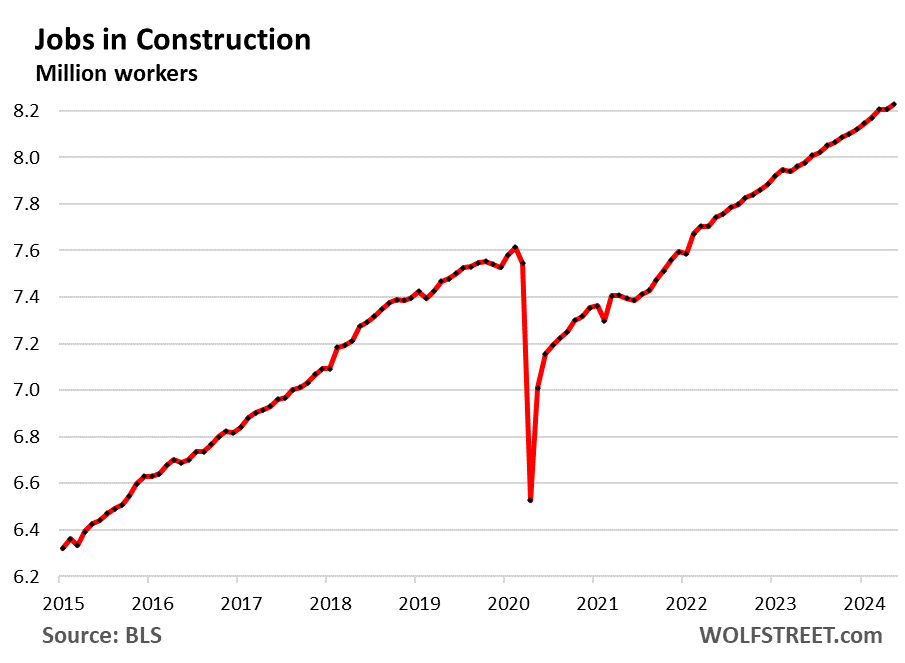
Manufacturing when through a huge hiring boom during the pandemic and employment is has plateaued at very high levels. Automation rules. Fewer people produce more things:
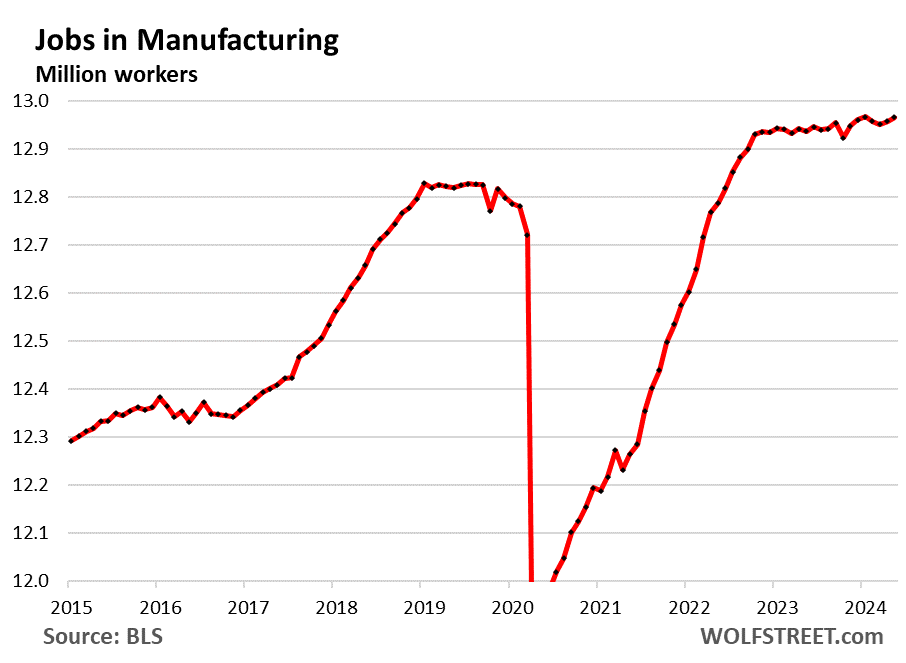
Here are some of the others you mentioned:
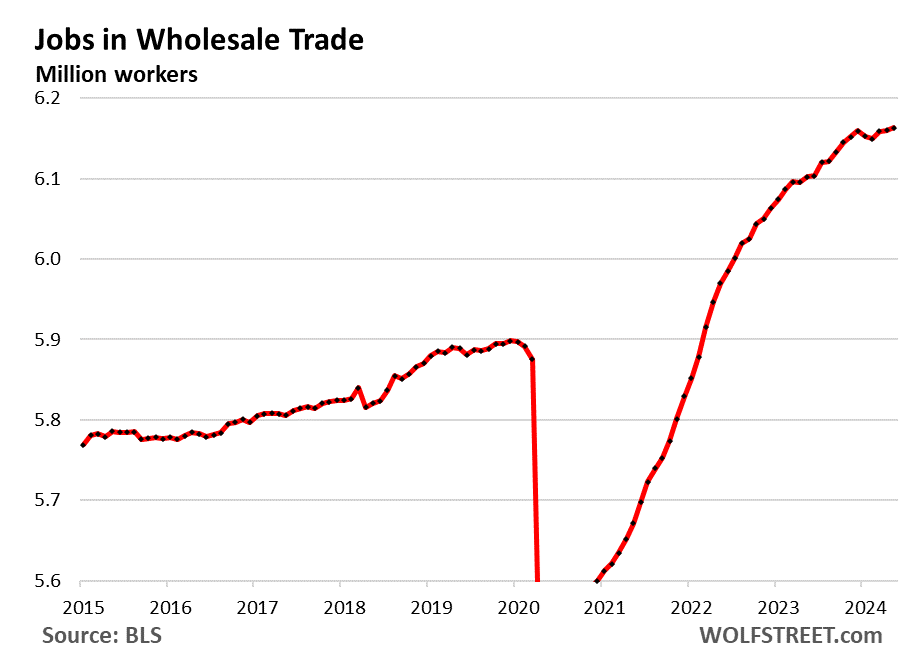
Thanks, Wolf. Another great analysis. For those of us who are legally blind, it is difficult for me to clearly see the charts (even though I am a statistician). So, I rely on your narratives to explain what is going on. In this case, while I get your point about the month-to-month volatility, there is no point talking about it at all if it is meaningless noise. But if you are going to write about it, I think it is useful to categorize where exactly this job growth is coming from. For instance, last month the WSJ claimed that most of the recent job growth has been in government jobs. Would you agree with this claim? And, if not, then where is the job growth? In what areas of the economy? Thanks for your guidance and your excellent analyses, which are the very best out there.
Glen,
If you cannot see my charts, that’s a problem here, and I cannot help you, because that’s most of the info here. And if you rely on super-volatile month-to-month changes, you’re just fooling yourself, though they make stupid headlines in the media, including the WSJ.
So have a look and see what you can get out of it. This is each major industry, with a chart, which you may not be able to see, so you will miss 99% of the data. But there are also some numbers (total employment and 3-month growth to iron out the month-to-month squiggles):
https://wolfstreet.com/2024/06/08/longer-term-trends-of-employment-by-industry-category/
Glen:
As one close to similar level of visual challenges, I suggest that you
1. consider manipulating the brightness and contrast of your viewing screen;
2. get a larger screen if that doesn’t do it.
If you cannot do it, find a youngster to help you.
(Those, including nephews, have all helped this old guy,, LOL )
Glen,you should have at top of your screen somewhere depending on browser a 100% with a + on the right and a – on the left,click the plus a few times to enlarge print or in this case the charts/hope this helps.
The US has done great things in oil/gas, but is a net importer of crude oil. To understand energy systems, and the economies that they underpin, it’s important to clearly understand what is happening. Conflagrating crude oil, gas and petroleum gives an inaccurate understanding. US net imports, Mb/d:
Crude oil: +2.7
Refined prod: -1.7
Nat gas liquids: -2.2
The US net imports crude oil, about 1.1 Mb/d. There is refinery gains in the oil vs refined products categories.
Natural gas is in great supply, while crude is scarce, as seen in more remote oil fields, gas is reinjected while oil is valuable enough to cover transport costs. We heat with gas, not oil.
Interesting/important to note, the other major producers manage oil price through production quotas. The US exports LNG because it’s a giant island. Production in Eurasia can be moved via pipe. Only other islands (physical or political) need LNG.
Good lordy!!! The US imports crude oil, refines it, and EXPORTS the resulting value-added petroleum products, such as gasoline, jet fuel, and diesel. Even California is doing that. It’s a huge business. The refineries in the Bay Area import crude and are big exporters of gasoline, diesel, and jet fuel to Mexico and South America. The Gulf Coast refineries do that massively. Other refineries do too. That’s what refineries do to make a profit.
https://wolfstreet.com/2024/03/04/us-production-exports-crude-oil-petroleum-products-soar-to-record-in-2023-strategic-petroleum-reserve-gets-refilled-slowly/
If inflation is running at about 5%, then an average wage increase of 4.1% means an actual reduction of 0.9%? How can it be truly called an increase? The rubbish days of ZIRP are fortunately historic and all ‘increases’ are meaningless unless inflation adjusted. Inflation affects everyone differently, those who have low or no debt get richer and big borrowers are punished.
Wolf,
I was wondering if it is normal to have a huge discrepancy between non adjusted and seasonally adjusted employment figures.
Here’s why I’m inquiring. Statistics Canada just reported on its labor force survey employment figures for May 2024 and this was recently pointed out –
Seasonally Adjusted:
Full time -35,000 jobs lost.
Part time +62,000 jobs gained.
Non adjusted:
Full time +386,000 jobs gained.
Part time -41,000 jobs lost.
I admit to knowing pretty much nothing about the the formulas and methodologies used to calculate seasonally adjusted figures. I understand that it can follow and average out trend cycles year over year for that particular month of the year. I wasn’t sure if it was my lack of knowledge and surprise comparing the stats – or is this big of a contrast fairly normal? Thanks for any feedback Wolf.
1. RTGDFA. You’re citing data from the household survey. READ what I said about the household data.
2. RTGDFA. You’re citing month-to-month changes (of household survey data). READ what I said about month-to-month changes.
3. Yes, employment is HUGELY seasonal (including through temporary jobs for the shopping season and summer jobs).
YOU PEOPLE HAVE TO READ THE ARTICLE BEFORE YOU POST COMMENTS. I will delete comments from people that obviously haven’t read anything here.
When I was the CEO of a company with 500+ employees, I learned the importance of the saying “If people don’t understand your message, the problem is with the person trying to communicate it.” In other words, if your goal is to communicate with your readers, and your they are asking what appear to be “dumb” questions, then maybe you need to slow down and explain things in more depth. You may be assuming that your readers have your depth of knowledge, and that things that are obvious to you are therefore obvious to them. I ran into this many times at my education company, which was full of math PhDs. Some of them had a very difficult time understanding why math concepts that were so obvious and intuitive to them, were causing difficulties for many students. That being said, in your defense, you are an excellent writer and perhaps readers should re-read your articles before leaving certain comments.
The wolf whisperer. With a little scratching to the underside wolf becomes a gentle, kind and benevolent creature.
You’re kidding, right. If people don’t read the article and then post dumb stuff about the topic of the article, it’s my fault that they didn’t read the article?
You didn’t read article either, right? You have no idea what it’s about, and so you have no idea what my reply to ScrappyDoo was about. You cannot understand that stuff unless you read the article.
I have some homework for you:
Google RTGDFA.
Perhaps you should require a quiz.
I was told there would be no quiz’s !?!
Why would employment not be seasonal? Think of all the outdoor jobs that vary by season – plowing snow in the winter, cutting grass in the summer. That and the holiday jobs Wolf mentioned.
Personal example; I work pt on a boat 7 months out of the year (May-Sept). Ferry demand to popular summer vacation spots is of course seasonal.
You’re not necessarily considering all of the complexities. Millions of people don’t actually have to work. Lots of folks have a spouse bringing in enough to maintain the household, or have small inheritances that they can live off of if necessary. Dependent on local conditions in employment and wages, these folks decide to either join the workforce or leave it, impacting both the labor participation rate and unemployment rate. When looking for a job, they get suddenly counted as unemployed and the the labor participation rate goes up. When they quit to stay home for awhile, the opposite happens.
I follow Wolf & FRED for the national picture.
As a mom & pop business in flyover I track my local manufactures, trucking, and construction. Our view does not match the surveys….
but we are not even a tiny blip in regard to national.
Wolf,
Do you have a sense of how long it would take to start getting rid of the 2K+ publicly traded zombie companies at current interest rates?
I hate to be the kid in the car on the road trip saying it incessantly, but “are we close yet?”
Lots of the zombies are getting refinanced right now in debt restructurings that wipe out part of the existing debt; this is done as an alternative to a debt restructuring in bankruptcy court. This reduces the debt load of these companies and might make them more viable.
Wolf,
Thank you for your insights, very valuable!
I read elsewhere that perceived inaccuracies with the BLS’s “birth-death model” could mean approx 85% of the may job count is overstated.
What are your thoughts around that?
That’s BS. The “birth-death” model refers to companies being created (birth) and dying (shut down). Not to people.
This report should not have been a surprise to anyone. The latest Chicago Fed Index of National Financial Conditions is the loosest since the end of ZIRP.
Your blog is a breath of fresh air in the crowded online space. I appreciate the unique perspective you bring to every topic you cover. Keep up the fantastic work!